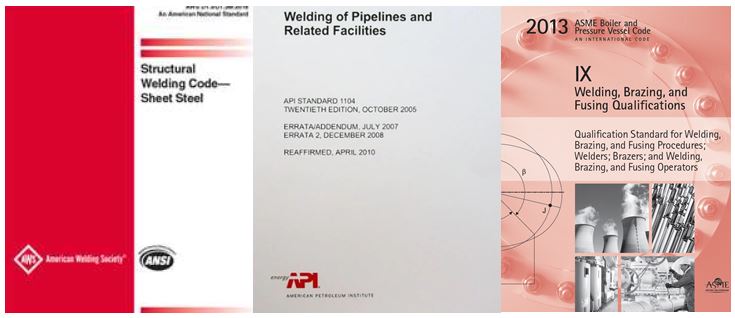Whenever we think about qualifying welders we typically think about welding codes such as one of the AWS structural welding codes, API 1104 or ASME Section IX. In most cases qualifications are carried out to comply with a customer requirement. But what if you simply want to qualify your welders as part of your own internal quality control program? How can you create a set of standards that are meaningful to the work that you do?
There are many ways to do this. We recommend that our customers choose one of the following:
- Use a welding code that applies to the work you are doing
- Use AWS B2.1 – Specification for Welding Procedure and Performance Qualification
- Develop your own standards
The reason we recommend using codes or standards (1 and 2 above) is because there is no need to reinvent the wheel when it comes to verifying that your welders can deposit sound welds. Established codes and standards provide requirements and instructions on how to qualify welders and they provide acceptance criteria for weld tests.
There is one valid reason in choosing not to follow codes or standards: you want your testing to be very specific to your application. For instance, if your welds don’t have any structural requirements, you may not want to follow a code that demands performance levels way above what is needed. Maybe you are just looking for the weld to provide a seal to keep water out. If this is the case, a simple test for no leaks may be a better qualification test than following the requirements in AWS D1.1 or any other of the structural welding codes. However, as you’ll see when we discuss developing your own standards, even in this case you can use published standards as your basis.
So let’s discuss the three options on how to get started for qualifying your welders when there is no requirement to follow a specific code.
- Pick an applicable welding code
Simply take a look at what you are welding and pick a code whose scope covers your work. For example, if you are welding mezzanines for a production facility you will probably look for one of the structural welding codes. If you are welding steel mezzanines you would go with AWS D1.1 – Structural Welding Code – Steel. If they are aluminum then use AWS D1.2 – Structural Welding Code – Aluminum. If you are welding pipe, consider using API 1104 or if it is structural pipe go with AWS D1.1 (Clause 9).
A powerful benefit of using a code is that they not only provide instructions and requirements for qualification of welders and procedures, but they also provide information on design, fabrication and inspection.
- Use AWS B2.1 – Specification for Welding Procedures and Performance Qualification
Some fabricating shops see a vast array of products going through the plant. One day they weld on sheet metal and the next day they weld on earthmoving equipment components. AWS B2.1 has the requirements for the qualification of welders just like AWS D1.1, D1.2, D1.6, ASME Section IX and others, but it is not specific to an application or material type. Although different material types will require multiple qualifications, you only have one standard to follow.

AWS B2.1 provides general requirements for the qualification of welding procedures and welder performance.
Unlike some of the above mentioned codes, AWS B2.1 is only a standard and will not provide information related to design, fabrication, repairs and inspection. However, if you follow this method you will have welders qualified based on AWS standards. This carries a lot of way when it comes to giving your customers assurance that you run a solid quality control program.
- Develop your own standards
If your welding jobs are “non-traditional” and are simple enough to where using a code or standard would impose excessive testing, you may want to develop your own standards for welder qualification.
This route allows you to base your acceptance criteria on visual inspection alone if you are not concern about weld strength or other requirements. If a weld is strictly cosmetic you may not be too concerned about achieving fusion to the root of the joint. You can also base your inspection on a test developed internally. Maybe your biggest concern is that the welds provide a seal. In this case you may want your qualification test to mimic that requirement instead of using macroetch and fillet break tests.
The good news is that even if you choose this route you can still use AWS B2.1 as your standard. This standard gives the fabricator the option of using predetermined welder qualification tests, or using their own tests and acceptance criteria. But because you are following the prescribed documentation process you are in essence complying with an AWS standard which adds to the credibility of your quality program in the eyes of the customer.
Regardless of the route you choose, the most important thing is that the qualification process is robust enough to provide reasonable assurance that your welders can deposit sound welds. You also want to make sure that the process and all testing and results are documented. This will protect you from liability should there be an issue with your products. Unfortunately, welding is many times the first thing to get blamed when there is a failure. If you have a way to prove that you have systems in place to prevent failures you may have a fighting chance in court.
 Do you want more information on how you can perform your own welder and welding procedure qualifications?
Do you want more information on how you can perform your own welder and welding procedure qualifications?
“Qualification of Welding Procedures, Welders and Welding Operators” is a guide developed to help you perform your own qualifications in full compliance to AWS D1.1 Structural Welding Code.


Please note: I reserve the right to delete comments that are offensive or off-topic.